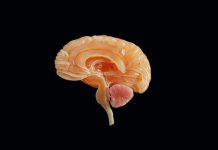
Messy tangles of a protein called tau can be found in the brains of people with Alzheimer’s disease and some other neurodegenerative diseases.
In Alzheimer’s, the tangles coalesce just before tissue damage becomes visible in brain scans and people start to become forgetful and confused.
In a new study, researchers found that brain immune cells called microglia—which are activated as tau tangles accumulate—form the crucial link between protein clumping and brain damage.
They found that eliminating such cells sharply reduces tau-linked brain damage in the mice—and suggests that suppressing such cells might prevent or delay the onset of dementia in people.
The research was conducted by the Washington University School of Medicine.
Under ordinary circumstances, tau contributes to the normal, healthy functioning of brain neurons.
In some people, though, it collects into toxic tangles that are a hallmark of neurodegenerative diseases such as Alzheimer’s and chronic traumatic encephalopathy.
This is a progressive brain disease often diagnosed in football players and boxers who have sustained repeated blows to the head.
The team previously had shown that microglia limit the development of a harmful form of tau.
But the researchers also suspected that microglial cells could be a double-edged sword.
Later in the course of the disease, once the tau tangles have formed, the cells’ attempts to attack the tangles might harm nearby neurons and contribute to neurodegeneration.
To understand the role of microglial cells in tau-driven neurodegeneration, the team studied genetically modified mice that carry a mutant form of human tau that easily clumps together.
Typically, such mice start developing tau tangles at around 6 months of age and exhibiting signs of neurological damage by 9 months.
Then, the researchers turned their attention to the gene APOE.
Everyone carries some version of APOE, but people who carry the APOE4 variant have up to 12 times the risk of developing Alzheimer’s disease compared with those who carry lower-risk variants.
The researchers genetically modified the mice to carry the human APOE4 variant or no APOE gene.
For three months, starting when the mice were 6 months of age, the researchers fed some mice a compound to deplete microglia in their brains. Other mice were given a placebo for comparison.
The team found the brains of mice with tau tangles and the high-risk genetic variant were severely shrunken and damaged by 9½ months of age—as long as microglia were also present.
If microglia had been eliminated by the compound, the mice’s brains looked essentially normal and healthy with less evidence of harmful forms of tau despite the presence of the risky form of APOE.
Further, mice with microglia and mutant human tau but no APOE also had minimal brain damage and fewer signs of damaging tau tangles.
Additional experiments showed that microglia need APOE to become activated. Microglia that have not been activated does not destroy the brain tissue or promote the development of harmful forms of tau.
The team says microglia drive neurodegeneration, probably through inflammation-induced neuronal death.
But even if that’s the case, if people don’t have microglia, or they have microglia which can’t be activated, harmful forms of tau do not progress to an advanced stage, and people don’t get neurological damage.
The findings indicate that microglia are the linchpin of the neurodegenerative process—and an appealing target of efforts to prevent cognitive decline in Alzheimer’s disease, chronic traumatic encephalopathy, and other neurodegenerative diseases.
The compound the team used in this study has side effects that make it a poor option for drug development, but it could point the way to other compounds more narrowly tailored to microglia.
One author of the study is David Holtzman, MD, the Andrew B., and Gretchen P. Jones Professor and head of the Department of Neurology.
The study is published in the Journal of Experimental Medicine.
Copyright © 2019 Knowridge Science Report. All rights reserved.



